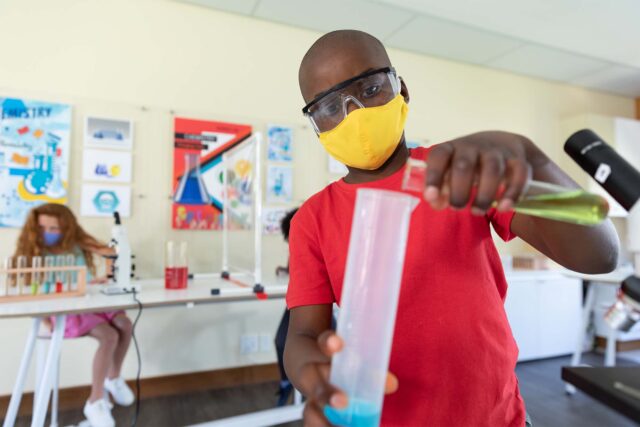This commentary was published by EdSource on September 8, 2022.
Living through a global pandemic while facing the consequences of climate change has underscored the need for science literacy. What’s more, robust and equitable science education is not only essential to a fully functioning democracy, it is crucial for preparing our future workforce and paving the way to well-paying employment. However, science has long been a low priority in California K–12 schools, and COVID-19 has disrupted efforts to ensure that all students receive a quality science education.
The US lags behind other developed countries in science education, and California ranks near the bottom of states on the National Assessment of Education Progress (NAEP) in science. On the 2015 NAEP (the latest state comparisons available), average science test scores in California were well below the national average. Only one in four 4th and 8th graders were proficient—a share that has been unchanged for years. California also has the largest science achievement gaps by race/ethnicity and family income.
In 2013, the State Board of Education laid the groundwork to transform science teaching by adopting the California Next Generation Science Standards (CA NGSS). These standards have the potential to improve students’ conceptual understanding of science, promote science literacy, and strengthen the global competitiveness of California’s workforce.
Districts were in the early stages of implementing CA NGSS when COVID-19 hit, abruptly changing every facet of the education landscape. A recent Public Policy Institute of California (PPIC) report shows that disruptions from COVID-19 could affect science education for years to come. This report finds that:
Before spring 2020, implementation of CA NGSS was moving forward—though progress was uneven.
More than 90% of districts surveyed said that they were implementing CA NGSS during the 2019–20 school year, up from 78% in 2016–17. Implementation was uneven by grade levels: districts were more likely to be implementing CA NGSS in K–8 than in high schools. There was also geographic variation, with only 38% of rural school districts implementing CA NGSS in high schools.
COVID-19 derailed science education.
Science education became a lower priority for a solid majority of districts (62%) during the 2020–21 school year. This delayed key CA NGSS implementation activities—such as aligning instructional materials and course models with the standards.
Several factors contributed to science being deprioritized, such as a continued emphasis on English language arts (ELA) and math (which predated the pandemic), staff shortages, teacher burnout, and a lack of dedicated funding for science education.
Overall, districts provided limited support for science education amid the pandemic. During the 2020–21 school year, 60% of districts provided supplemental instructional materials, 43% provided summer science programs, and 40% addressed social-emotional learning in support of science education. Only a quarter of districts provided small group instruction, and very few offered extended science learning time during the regular school year. Only 40% of districts provided additional support to English Learners in science instruction.
One silver lining was that some high-need districts—including those with large English Learner populations—continued to use science content to engage students in ELA and math. This helped ensure that science education continued in these districts amid the pandemic.
Most school districts do not plan to prioritize science education during the recovery.
Just one in four districts (27%) say that science education is a high priority in their recovery plans, compared to 80% prioritizing ELA and math. In addition, our review of the current Local Control and Accountability Plans (LCAPs) from over 800 districts shows that less than half plan to adopt, develop, or purchase new science instructional materials in the next few years, while around one-third plan to provide science teacher training or set student performance goals on standardized tests.
Prioritizing science education as California emerges from the pandemic—and beyond
Our research suggests that science education in California is far from the priority it could be. And as schools continue to recover from the pandemic, educators and policymakers should bear in mind the need to invest in science literacy.
The 2022–23 state budget includes $85 million to support professional learning in math and science—a significant step. The state could also include science indicators in district accountability requirements and encourage districts to dedicate more resources to science education. Further, the state could support science education during the recovery by providing teachers and districts with guidance on evidence-based strategies that produce stronger and more equitable student outcomes.
Moving forward, all educational partners will need to come together to heighten the urgency among policymakers and secure resources and support that enable California to realize its vision for science education and science literacy.





